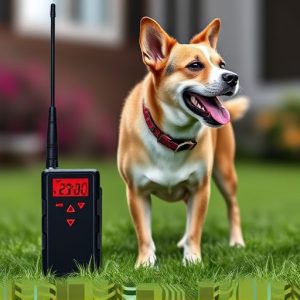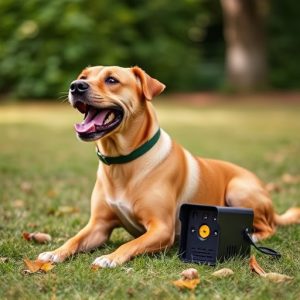Electronic Barking Dog Alarms: Types, Setup & Benefits
Electronic barking dog alarms offer a modern, humane approach to managing canine noise. These device…….
Electronic barking dog alarms offer a modern, humane approach to managing canine noise. These devices, with customizable settings and various sensor options, protect properties while considering household peace. By understanding your dog's characteristics and choosing the right model, you can install and set up an effective alarm system. A strategic placement guide ensures optimal performance, minimizing false triggers and stressing pets. Responsible use alongside positive reinforcement techniques enhances their effectiveness as modern security solutions.
“Unleash peace of mind with an electronic barking dog alarm—a sophisticated solution for managing your canine companion’s vocalizations. This comprehensive guide, ‘Understanding Electronic Dog Alarm Sounds,’ explores the intricate world of these devices, offering a detailed overview of their functionality and impact. From types available in the market to selection tips and installation, we demystify the process. Discover the benefits, consider essential factors, and transform your dog’s barking into a manageable aspect of pet ownership.”
Understanding Electronic Dog Alarm Sounds: A Comprehensive Overview
Electronic dog alarm sounds are designed to protect your home and deter intruders, all while ensuring your furry companion’s safety and well-being. These advanced systems go beyond traditional barking by offering a variety of audio signals tailored to different situations. Understanding the components that make up these alarms is key to choosing the right one for your needs.
The core of an electronic barking dog alarm system is its sensor, which detects movement or vibration. When activated, it triggers a pre-programmed response, such as a high-decibel bark sound, designed to startle and alert potential intruders. These alarms often feature adjustable settings, allowing users to customize the sensitivity and type of bark sounds, ensuring they fit seamlessly into any household environment without causing unnecessary distress.
Types of Electronic Barking Dog Alarms Available in the Market
The market offers a diverse range of electronic barking dog alarms designed to address different needs and preferences for pet owners. These devices are an innovative solution for those seeking effective, yet humane, ways to deter unwanted barking. One common type utilizes ultrasonic sounds, emitting high-frequency waves that are inaudible to humans but irritating to dogs. This approach is often preferred as it doesn’t involve loud, potentially distressing noises for neighbors or other pets.
Another popular variety employs a combination of sensors and vibration. These alarms detect a dog’s bark through microphone sensors and respond by emitting a localized vibration, which can be effective in calming anxious or excitable dogs. Some models even incorporate LED lights that flash when triggered, providing an additional visual deterrent. For those with larger properties, wireless systems offer flexibility, allowing for placement away from power sources, while wired options are cost-effective and reliable for indoor use.
How to Choose the Best Electronic Dog Alarm for Your Needs
When selecting an electronic dog alarm, understanding your specific needs is key. Consider the size and breed of your dog – larger breeds with deeper barks may require a more powerful alarm to effectively deter intruders. Additionally, think about the environment where the alarm will be used; outdoor alarms should withstand varying weather conditions.
Features like adjustable sensitivity settings and different sound options are valuable. Some alarms offer motion sensors for improved security, while others have remote controls for convenient operation. Choose an alarm with a long-lasting battery life and easy setup instructions to ensure hassle-free installation and reliable protection. Remember, the best electronic barking dog alarm is one that matches your dog’s unique characteristics and your specific security requirements.
Installation and Setup: Step-by-Step Guide
Installation and Setup: Step-by-Step Guide
To install your new electronic barking dog alarm, start by choosing a strategic location outdoors where it can detect movement and potential intruders effectively. Typically, this is near entry points like doors or windows. Ensure the area has good line-of-sight without obstructions. Next, dig a small hole to bury the sensor unit, keeping it level with the ground for optimal performance. Connect the sensor to the control panel using the provided cable, ensuring a secure and weatherproof connection.
Attach the control panel to a wall or post nearby, positioning it in plain sight to deter potential thieves. Plug in the power supply and arm the system according to your preferences. Test the sensors by moving around in the detection zone to ensure they trigger the alarm with accurate sensitivity. Adjust the settings as needed until you’re satisfied with its performance.
Benefits and Considerations for Using an Electronic Dog Alarm
An electronic barking dog alarm offers a modern and effective solution for addressing unwanted canine noise, providing several benefits to both pet owners and neighbors. Unlike traditional barking dogs that can create disturbances throughout the day or night, these alarms are designed to respond only to excessive or persistent barking, triggering a loud sound to deter the dog without causing harm. This selective activation ensures that the alarm is effective in preventing nuisance without needlessly startling the animal.
When considering an electronic barking dog alarm, several factors should be kept in mind. Placement is crucial; the device needs to be strategically positioned where it can accurately detect barking sounds while avoiding false triggers from other noises. Additionally, some models may have limitations on range or sensitivity, so testing and adjustment might be necessary for optimal performance. Lastly, while these alarms are meant to train dogs by associating excessive barking with an unpleasant sound, responsible use and combination with positive reinforcement techniques are essential to avoid unwanted stress or fear in the animal.


